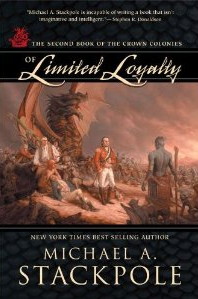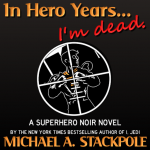The New Midlist Writers
At the World Fantasy Convention in San Diego I had someone say to me, “Look, no offense intended, but you’re a midlist author, and you’ve made that work for you.” The remark was made in the context of a discussion of digital publishing. The speaker’s point was that midlist authors, if they are going to survive, are going to make a transition into being either purely independent authors, or some hybrid where they have some traditional contracts and do indie publishing on the side.
Deciding who and what a midlist writer is in this day and age is very difficult. In many ways it’s easier to define the other classes of writers. Obviously we have the brand-name, best selling authors who top the lists like Rowling, King, Clancy, DeMille and Dan Brown. Close to them are the genre bestsellers—those authors who rock the charts in their niches and often hit the national lists. Their sales are huge. They are the superstars. Publishers need their sales and see to it, through promotional pricing and other efforts, that these authors will continue to sell well.
Then there are the beginning authors. I’d peg them as anyone who has had three or fewer books published by traditional publishers. These folks are midlist-authors-in-waiting. With many publishing houses giving an author two books to make it big or turn to another name, these brand new authors don’t have the sales numbers to determine yet where they’re going. Some of them might actually break out and make it into the brand-name set—though, in the past, such success has normally been the result of a dozen years laboring in obscurity until a book hits.
Then there’s everyone else. We’re the midlist.
In the past—we’re talking 20th Century here—the midlist authors were those who were on books 4+, working at a series, building up a readership. Back in the old days, before publishing had contracted into the big six, publishers would give writers 4-5 books to find their audience. I seem to recall it was the late 80s when the policy of “two books and out” got instituted amongst publishers, and that was after the consolidation of the industry had put bean-counters in charge of return on investment.
It wasn’t just accountants for the publishers that killed the midlist. Bookstores made use of the liberal returns policies publishers offered to return slow-selling books. Midlist authors, you see, used to benefit from what’s known as the long-tail. This is the idea that a reader who discovers your new book will buy up your previous books. Because those older books take up shelf-space that could be given over to newer books that sell faster (churn-rate is the term used to describe how fast they sell), readers couldn’t find older books in stores.
In the 1980s, when the Reagan administration revamped the tax code, the cost of warehousing titles shifted from being a business expense to being a cost of inventory. It worked like this: if a paperback that cost .40 to print cost .05 to store for a year, at the end of that year the book would be considered worth .45 for tax purposes. This increased the value of inventory, which increased pre-tax profits. As a result, slow-selling books weren’t worth the money to warehouse. To appease the accountants, old books got scrapped.
Back in those days, many a midlist author made a good living on backlist sales. Science fiction and fantasy had especially strong backlist sales. With stores cutting those books, however, and the IRS making it difficult to keep them in stock, publishers had to look at new strategies for turning a buck. Since backlist wouldn’t sell, they had to expand their lists to put more front list (or new) titles out there—knowing those titles would have a much shorter sales cycle. This was really the first step in the periodicalization of novels. By the early 1990s one would regularly discover that a book which had won an award for excellence the year before was already out of print.
The closing of Borders and the shrinking of shelf space at Barnes & Noble has placed further pressure on book sales. Now, even if you have a book make it to a store’s shelves, the chances that it will be there longer than four months are slender. If someone wants a backlist title—say the preceding book in the series—chances are excellent they will be referred to a website to special order it, or to order the electronic copy.
For as long as I can remember, folks have said the midlist was dying. In the 80s and 90s I recall having the blame laid at my feet because I, after all, was writing tie-in fiction which, I was told, was what was destroying the midlist. What those angry writers missed was that publishing, store and governmental practices had doomed the midlist, and tie-in books were an artificial measure to try to hang on to that center of the line. Go to a bookstore now and you’ll even find the tie-in section has shrunk.
In its place we see the rise of the fad shelves. Again, these are an attempt by publishers and retailers to pile-on and profit from a popular trend. Can’t fault them for trying. The problem is that when publishing teen vampire angst novels takes up half of the dozen books that used to comprise your SF line, authors who used to write perfectly good SF find no place to sell their work.
Unless they join the new midlist and self-publish it digitally.
Midlist authors used to be defined by sales levels, but now they’re the writers who refuse to abandon their readers and their passion. They are the writers who are doing what they must to survive in the current environment. Midlist writers are the ones who came into publishing with the dream of seeing their books on bookstore shelves. As that dream became more difficult to realize—through no fault of their own—they turned to other methods to get the word out about their work. Midlist writers are the ones who are willing to learn new things and embrace change, so they can continue to do the things they love and, hopefully, make enough money at it to keep them going.
I love being a storyteller. It makes me smile when someone posts a note saying they liked the last book and want to see more. It still freaks me out when fully grown adults tell me about how they were reading me in high school, and how a book like I, Jedi helped them learn life lessons. You have no idea how much of an honor it is to have someone send me a picture of a child they’ve named after one of my characters (works for dogs and cats, too, but more so children). And when someone tells me that they decided to write, or they decided to keep at writing because of stuff they’ve learned from me, wow.
That’s the kind of thing that takes your breath away.
The thing about being a midlist author in this new digital age is this: the label midlist is a label from traditional publishing. It doesn’t define us anymore. That’s part of being independent, part of taking responsibility for what we’re doing with our careers. Some folks will use the label midlist like a skewer. They’ll use it dismissively, in the same tone of voice with which they use self-published. They’ll intend it to hurt.
But it shouldn’t.
And it doesn’t.
The one thing you need to remember about people like that is that they’re speaking from fear. They’re afraid that their rocket to the top is going to fail—when really it’s the legacy publishing environment that fails them. They’re afraid they’re going to have to tell their friends and family that their publisher dropped them, or that their last book bombed.
And they’re especially afraid, when they do that, that the rest of us are going to point and laugh because when hubris catches up with you, it can be so tempting for others to gloat.
I won’t be doing the pointing or laughing.
I’ll be the guy welcoming them to the new reality. I’ll be the guy encouraging them to make their backlist available digitally. I’ll do my best to point them in the right direction, offering all the help and advice I can. Because out here, outside the legacy labels, the only folks who will be looking out for us are us.
So, yeah, I am a midlist writer. I make it work for me.
No offense taken.
Writing up this series of blog posts is cutting into my fiction writing time. If you’re finding these posts useful, and haven’t yet gotten yet snagged my latest novels, please consider purchasing a book. Nice thing about the new age of publishing is that you become a Patron of the Arts, letting writers know what you’d like to see more of simply by voting with a credit card. (Authors charge less when they sell direct, so you save, we make more, and that frees us to write more.)
 My latest paper novel, Of Limited Loyalty, is due out in December and is available for pre-order now.
My latest paper novel, Of Limited Loyalty, is due out in December and is available for pre-order now.

My digital original novel, In Hero Years… I’m Dead is available for the Kindle and in the epub format for all the other readers, including the Nook, iPhone, iPod Touch and iPad. (Imagine the Batman, Watchmen and Kick-Ass movies all rolled into one, as written by Dashiell Hammett, and you’ve pretty much got the idea of the book. Oh, and with some satire and political commentary slipped in for irony.)



 04. Nov, 2011
04. Nov, 2011 







12 Responses to “The New Midlist Writers”